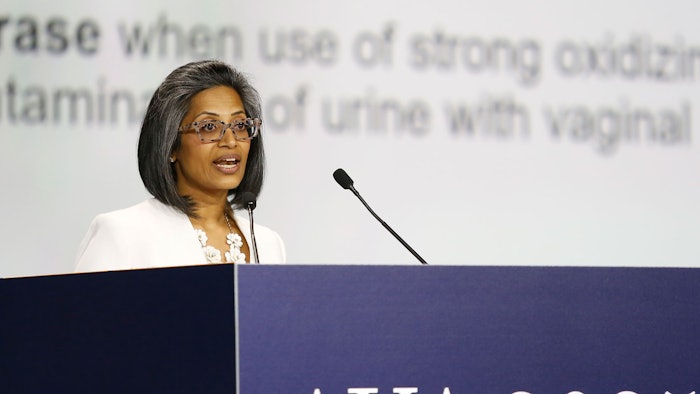Positive dipstick: proceed or postpone?
Crossfire debate argues what to do when a patient tests positive on procedure day.
What should be done when a patient scheduled for an office procedure has a positive urine dipstick? There are no clear guidelines, and the evidence is unclear. Stephanie Kielb, MD
Stephanie Kielb, MD
“Do we cancel, or do we go ahead?” asked Stephanie Kielb, MD, professor of medicine at the University of Michigan School of Medicine. Dr. Kielb moderated a Crossfire debate on the impact of a positive urinalysis on the day of an office procedure.
“I got convinced both ways, so I guess we might call it a draw,” she said at the conclusion of the debate during the Plenary on Monday morning. “As with any intervention, the physician must weigh the risks versus the benefits.” Kamran Sajadi, MD
Kamran Sajadi, MD
Kamran Sajadi, MD, associate professor of urology at Oregon Health and Sciences University School of Medicine, opened the debate for Team Cancel.
“So sorry to be the bearer of bad news, but you do need to cancel that patient with the positive urinalysis for urodynamics,” he said.
A 2017 policy statement on antibiotic prophylaxis for urodynamics from the Society of Urodynamics, Female Pelvic Medicine and Urogenital Reconstruction (SUFU) is the closest we have to guidelines, Dr. Sajadi said. The statement says clinicians should order a urinalysis before each urodynamics and, if the patient has a urinary tract infection (UTI), treat and reschedule the procedure.
On the practical side, he added, a UTI can falsify urodynamic results, and the procedure can exacerbate the infection.
A positive urinalysis should also cancel a botulinum toxin A treatment. Turbid urine obscures visualization and there is no symptomatic distinction between UTI and asymptomatic bacteriuria (ASB).
“Where else in medicine do we intentionally perform an injection into a purulent field?” he asked. “Is it ASB? Then why are you doing a Botox on an asymptomatic patient? In addition, the [Food and Drug Administration] and the manufacturer both told you not to do it. You better believe the plaintiff’s attorney is going to bring this up. Cancel, reschedule and bring them back.”
Not the smart choice, retorted Nitya Abraham, MD, associate professor of urology at Montefiore Einstein. Half of patients with cancelled appointments never reschedule, and those who do reschedule face long delays due to the shortage of urologists.
“In the right scenario, you can proceed full steam ahead,” Dr. Abraham said. “A positive dip is positive nitrite, leukocyte esterase or blood. What is most positive for UTI is any combination of nitrite, leukocyte esterase or blood. We know there is a discrepancy between dipstick results and what is seen on microscopy.”
Hemoglobinuria, myoglobinuria, menstrual blood, concentrated urine and even strenuous exercise can give false-positive blood on the dip. Prolonged sample exposure can lead to in vitro nitrite formation. The presence of strong oxidizing agents, colored urine or mucus contamination can produce false-positive leukocyte esterase.
“The best practices policy statement of urodynamics says if the urine dip is positive and the patient is asymptomatic, send the urine for culture, go ahead with urodynamics and give prophylactic antibiotics. It’s probably safe to proceed,” Dr. Abraham said. Siobhan Hartigan, MD
Siobhan Hartigan, MD
Probably safe is not good practice, shot back Siobhan Hartigan, MD, director of reconstructive urology and pelvic health at Hunterdon Urological Associates.
“It’s not worth the risk,” she said. “There is a potential for hospitalization following cystoscopy that is small but still present.”
Dr. Hartigan added that UTI-related medical visits account for up to 6% of all medical visits in the U.S., have a mortality rate of 2.3% and cost an estimated $1.6 billion annually. The mean cost of an uncomplicated UTI hospitalization is nearly $8,000 with a four-day length of stay, and it is far more for a multidrug-resistant infection.
UTI risk and multidrug-resistant infections are both on the rise. Between 1990 and 2019, UTI incidence increased by more than 60%, with a 2.4-fold increase in mortality.
“This burden of death from UTI increases with age,” she continued. “UTI patients in higher sociodemographic regions are often older with decreased immunity and more complications. We urologists treat these vulnerable populations. We have a responsibility: First, do no harm. For the most part, these are elective procedures. So do the safe thing, the right thing and cancel the procedure.” Yahir Santiago-Lastra, MD
Yahir Santiago-Lastra, MD
“It’s very easy to get into status franticus, becoming angry and sad, especially when looking at hospital-acquired UTI data,” Yahir Santiago-Lastra, MD, associate clinical professor of urology at the University of California San Diego School of Medicine, said with a smile. “We are looking at a 1.2% risk. That’s lower than your risk of being in a car accident or of getting food poisoning this year.”
She added that canceling urologic procedures based on dipstick results is not a solution. It simply delays care, harms patients, limits access and exemplifies defensive medicine, not patient-centered medicine.
Nitrite, leukocyte esterase or blood alone without symptoms does not diagnose infection, she emphasized. False positives are common, especially in postmenopausal patients.
SUFU clearly states that ASB should not be treated before most urologic procedures unless mucosal disruption is expected, and hospital-acquired UTI data are no reason to cancel an office procedure based on dipstick results.
The AUA already recommends individualized risk assessment, not a one-size-fits-all approach, Dr. Santiago-Lastra added.
“Our opponents may say that canceling is the safe thing to do, but the safe thing, the evidence-based thing, is to treat the patient, not the dipstick paper; to use judgment and not fear.”












